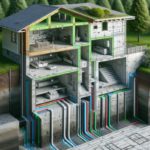Uncover the Essential Importance of Backflow Testing Services for Safeguarding Water Quality
Steps to Effectively Prevent Backflow and Protect Your Water Supply

Backflow Testing Services in Richmond play a pivotal role in protecting our water supplies from various contamination threats that can emerge from different sources. This vital process includes the meticulous installation of specialized devices aimed at preventing the reverse flow of water within plumbing systems. By adopting these measures, we can guarantee that potable water remains free from contaminants and safe for consumption. It is crucial for both homeowners and businesses to understand the many scenarios that can precipitate backflow incidents. For instance, a sudden drop in <a href="https://limitsofstrategy.com/water-pressure-issues-at-home-expert-solutions-from-plumbmaster/">water pressure</a> can create conditions where non-potable water inadvertently flows back into the clean water supply. To combat these risks, a variety of devices are employed, including:
- Reduced Pressure Zone (RPZ) Assemblies
- Double Check Valve Assemblies
- Pressure Vacuum Breakers
- Atmospheric Vacuum Breakers
- Inline Check Valves
- Ball Valve Assemblies
- Test Cocks
- Backflow Prevention Devices for Fire Protection Systems
These essential devices are utilised across a plethora of applications, from residential properties to expansive commercial facilities, ensuring that water systems function safely and efficiently.
Understanding Regulatory Requirements for Backflow Testing in Your Area
In Canada, a comprehensive framework of regulations mandates regular backflow testing to uphold <a href="https://writebuff.com/backflow-testing-services-ensuring-water-safety-in-north-vancouver/">water safety</a>. Compliance with these regulations is essential for both residential and commercial property owners and is governed by a combination of municipal and provincial legislation. Typically, local authorities require property owners to install and routinely test their backflow prevention devices. Key Canadian regulations encompass:
- Canadian Standards Association (CSA) standards for backflow prevention
- Provincial regulations aimed at ensuring water safety
- Municipal bylaws stipulating the frequency of testing
- Health and Safety codes that outline water quality standards
- Environmental Protection Agency guidelines for water systems
Adhering to these regulations is critical, not only for safeguarding public health but also for property owners to avoid potential fines and legal consequences.
The Essential Nature of Scheduled Backflow Testing for Health and Safety
Regular backflow testing is vital for maintaining superior water quality, reducing health risks, and ensuring compliance with local regulations. The benefits of routine backflow testing extend far beyond basic compliance; they play a crucial role in protecting public health, enhancing safety, and promoting environmental sustainability. Some of the primary advantages of consistent backflow testing include:
- Preserving the quality of drinking water
- Reducing health risks associated with contaminated water
- Ensuring compliance with legal and regulatory requirements
- Facilitating early detection and resolution of plumbing issues
- Enhancing property value through compliance and safety assurances
By highlighting the importance of backflow testing, property owners can guarantee that their water systems remain safe and healthy for all residents, as well as the broader community.
The Risks Involved with Neglecting Backflow Testing and Its Consequences

Failing to conduct backflow testing poses significant risks, including potential water contamination, health hazards, and legal complications. When backflow prevention devices are not routinely verified, they may malfunction, allowing harmful contaminants to seep into the potable water supply. The repercussions can be dire, affecting both health and financial stability. Property owners may encounter:
- Increased risk of waterborne illnesses
- Potential pollution of local water resources
- Severe fines from regulatory bodies
- Legal actions stemming from health-related claims
- Damaged reputation and reduced market value of properties
Maintaining a regular testing schedule is essential to avert these serious consequences and to uphold the integrity of water systems.
Expert Insights on Backflow Testing Services in Richmond
Identifying the Key Qualities of a Trustworthy Backflow Testing Service
The credibility of backflow testing services hinges on various factors, including certification, experience, and adherence to industry standards. In Richmond, reputable services are characterised by technicians who possess certifications from recognised organisations, reflecting their proficiency in backflow prevention and testing methodologies. Many well-established services in Richmond demonstrate a commitment to quality through positive customer feedback and compliance with regulatory standards. Typically, these companies:
- Employ certified backflow testers with extensive training
- Utilise advanced testing equipment
- Maintain an exemplary compliance record with local regulations
- Provide transparent pricing and comprehensive service reports
Potential clients should actively seek reviews and examples of successful past projects to evaluate reliability.
Determining How Often Backflow Testing Should Be Conducted

The frequency of backflow testing is influenced by the type of property and specific local regulations. In Richmond, backflow testing is generally performed annually or bi-annually, depending on the risk associated with the property's water system. For example, commercial establishments—especially those with high water usage or complex plumbing systems—may require more frequent testing. Property owners should consider the following steps to effectively coordinate backflow testing:
- Review local regulations to determine the mandated testing frequency
- Assess the type of backflow prevention device installed
- Consult with a certified technician to evaluate risks
- Schedule tests during off-peak water usage times to reduce disruptions
Regularly planning these assessments is crucial for ensuring compliance and protecting the water supply.
Understanding the Procedures Followed During a Backflow Test
A backflow test consists of a systematic evaluation of backflow prevention devices to confirm their proper operation. Property owners can expect that the technician will arrive equipped with specialized tools and adhere to a structured testing protocol. Typically, the backflow testing procedure includes:
- Visual inspection of the backflow prevention assembly
- Pressure testing to identify leaks or malfunctions
- Verification of the operational integrity of valves
- Documentation of findings and recommendations for repairs if necessary
This thorough approach not only identifies potential issues but also ensures compliance with local regulations. After the testing, the technician should provide a detailed report summarising the findings and any recommended actions.
Selecting the Premier Backflow Testing Service in Richmond
Essential Certifications Required for Backflow Testing Technicians
Technicians must hold certifications from recognised organisations, possess extensive experience, and have a comprehensive understanding of backflow prevention and testing protocols. These qualifications are essential to ensure that testing is performed accurately and in accordance with local regulations. Key certifications for backflow testing technicians include:
- Certified Backflow Prevention Tester (CBPT)
- Cross-Connection Control Specialist Certification
- Provincial plumbing licenses
- OSHA safety certifications
Confirming these qualifications during the selection process can significantly enhance the likelihood of receiving high-quality service.
The Importance of Local Knowledge for Effective Backflow Testing
Local expertise is vital when selecting a backflow testing service, as it ensures familiarity with regional regulations and the specific challenges related to the local water system. Richmond’s unique water supply and plumbing infrastructure present particular challenges that local professionals are better equipped to navigate. The benefits of choosing a local service provider in Richmond include:
- Understanding of local codes and regulations
- Awareness of common issues faced by Richmond residents
- Faster response times for service requests
- Established community relationships that foster trust
By opting for a local expert, property owners can ensure that their backflow prevention needs are addressed efficiently and effectively.
Methods to Evaluate the Credibility of a Backflow Testing Service
Assessing the credibility of a backflow testing service can be achieved through several strategies. Prospective clients can build their confidence in a service provider by conducting thorough research. Recommended steps include:
- Reading online customer reviews and testimonials
- Verifying valid certifications and licenses
- Engaging in direct communication to gauge responsiveness
- Requesting references from previous clients
Following these guidelines will assist in ensuring that you select a reputable backflow testing service capable of delivering reliable and compliant testing.
Identifying Common Challenges Encountered During Backflow Testing
Understanding the Different Types of Backflow Contamination
Backflow contamination is generally categorised into two primary types: backpressure and backsiphonage. Understanding the distinctions between these two categories is crucial for effective management and prevention strategies. Backpressure occurs when the pressure in a non-potable system exceeds that of the potable system, potentially allowing contaminants to flow backward. On the other hand, backsiphonage occurs when a drop in pressure within the supply line creates a vacuum effect, drawing contaminants into the potable water system. Addressing these challenges involves:
- Employing specific prevention devices designed for each type of backflow
- Conducting regular testing to identify vulnerabilities
- Educating the public on backflow prevention methods
- Implementing stringent plumbing design standards
By comprehending these categories, property owners can adopt proactive strategies to effectively mitigate risks.
Early Detection Strategies for Backflow Issues
Detecting backflow problems can be accomplished through various strategies, including visual inspections, pressure measurements, and specialised equipment. Professionals often commence with a visual inspection to identify any obvious signs of wear or damage. Pressure testing involves measuring the pressure differential across backflow prevention devices. Furthermore, advanced tools—such as pressure gauges and flow meters—provide detailed insights into system functionality. Common instruments utilised for detecting backflow issues include:
- Manometers for precise pressure measurement
- Flow meters to assess water flow
- Smoke testing for identifying leaks
- Digital testers for accurate assessments
These techniques enable technicians to confirm that systems are functioning correctly and to identify any necessary repairs.
The Consequences of Ignoring Backflow Issues
Overlooking backflow issues can result in severe consequences, including contamination of the water supply, which presents significant health risks and may lead to regulatory fines and penalties. Ignoring backflow problems not only jeopardises public health but also creates substantial liabilities for property owners. Potential repercussions include:
- Increased likelihood of waterborne diseases
- Legal actions arising from health-related claims
- Regulatory fines and penalties for non-compliance
- Long-lasting damage to community trust and property reputation
Neglecting backflow issues is not merely irresponsible; it can lead to costly repercussions.
The Documented Advantages of Backflow Testing Services in Richmond
Enhancing Public Health Standards Through Backflow Testing
Backflow testing is fundamental to maintaining the safety of the public water supply by preventing contamination, which is essential for the health of the community. Regular testing aids in identifying and rectifying potential issues before they evolve into significant health threats. Statistics indicate that communities with stringent backflow testing protocols experience markedly lower rates of waterborne illnesses. The impact of backflow testing on public health is extensive, encompassing:
- Reduced incidence of gastrointestinal illnesses
- Lower healthcare costs linked to waterborne diseases
- Improved community trust in public water systems
- Heightened awareness surrounding water safety issues
Thus, prioritising backflow testing is not simply a regulatory obligation; it is a fundamental aspect of ensuring public health.
The Economic Benefits Associated with Effective Backflow Prevention
Implementing effective backflow prevention can yield substantial financial advantages by minimising costs related to water treatment and avoiding potential fines for non-compliance. Property owners who prioritise regular backflow testing can evade expensive repairs and legal costs that stem from contamination incidents. The economic benefits of robust backflow prevention include:
- Lower expenses associated with emergency repairs and litigation
- Reduced water treatment costs due to proactive measures against contamination
- Increased property values through compliance and safety assurances
- Possible reductions in insurance premiums due to decreased risk
Investing in backflow prevention not only conserves resources but also enhances the overall value of properties.
Contributing to Environmental Sustainability Through Backflow Testing
Backflow testing is essential for environmental protection by preventing the introduction of contaminants into water systems. Environmental sustainability is a core consideration, as polluted water can have far-reaching negative effects on ecosystems and public health. Regular backflow testing contributes to environmental sustainability by:
- Safeguarding local water supplies for future generations
- Avoiding pollution of natural water bodies
- Supporting biodiversity through the maintenance of clean waterways
- Encouraging responsible water management and usage practices
Through diligent backflow testing practices, communities can work towards environmental protection while ensuring safe access to drinking water for all.
Best Practices for Backflow Testing in Richmond
Strategies for Efficient Scheduling and Documentation of Backflow Testing
Effective scheduling and comprehensive documentation are critical for maintaining compliance and ensuring successful backflow prevention. Keeping detailed records of testing dates, results, and maintenance actions can facilitate adherence to local regulations and assist in tracking trends over time. Best practices for organising backflow tests include:
- Establishing a testing calendar that aligns with regulatory requirements
- Maintaining a log for each backflow device, including testing dates
- Documenting technician details and findings from each test
- Storing records in an easily accessible digital format for convenient retrieval
Implementing these practices not only supports regulatory compliance but also fosters proactive management of backflow prevention systems.
Essential Maintenance for Backflow Prevention Devices
Regular maintenance is crucial to ensure that backflow prevention devices remain effective and comply with established regulations. Without proper upkeep, devices can malfunction, increasing contamination risks. Property owners should establish a maintenance schedule that includes:
- Routine inspections to detect wear and tear
- Cleaning and servicing devices in accordance with the manufacturer’s specifications
- Timely replacement of any defective parts to ensure proper functionality
- Documenting all maintenance actions for compliance tracking
By prioritising maintenance, property owners can extend the lifespan of their backflow prevention systems and mitigate the likelihood of costly repairs.
Responsive Actions Following Backflow Testing Results
Understanding and responding to backflow test results is crucial for addressing any issues in a timely and effective manner. Test outcomes can indicate whether backflow prevention devices are operating correctly or if repairs are needed. Steps to take based on varying backflow test results include:
- Reviewing the technician’s report for comprehensive findings
- Determining whether repairs or replacements are necessary
- Scheduling follow-up tests if problems are identified
- Updating maintenance logs and compliance documentation
Timely responses to test results are essential for preventing potential contamination issues and ensuring that water systems remain safe for all users.
Training and Certification Requirements for Backflow Testers
Proper training and certification are vital to ensure that backflow testers are qualified to conduct tests and maintain compliance with local regulations. Training programmes should encompass both theoretical knowledge and practical skills. Key components of training and certification include:
- Understanding local regulations and standards
- Hands-on experience with various types of backflow prevention devices
- Regular updates on advancements in testing methodologies
- Participation in continuing education programmes to maintain certification
Investing in the training of backflow testers is essential to equip them with the necessary skills to navigate the complexities associated with backflow prevention and testing.
Effective Strategies for Backflow Testing Services in Richmond
Core Components of a Successful Backflow Testing Program
A successful backflow testing programme incorporates consistent testing, thorough documentation, and adherence to local regulations. Key elements of an effective programme include:
- Establishing a dedicated schedule for testing and maintenance activities
- Engaging qualified technicians for testing and necessary repairs
- Maintaining detailed records for compliance verification
- Implementing ongoing educational initiatives for property owners and staff
For instance, numerous commercial properties in Richmond have successfully implemented backflow testing programmes that not only meet standards but also serve as exemplary models for best practices in water safety. This comprehensive strategy ensures the ongoing protection of public health and the environment.
Steps to Formulate an Efficient Backflow Testing Plan
Creating a backflow testing plan requires assessing needs, scheduling tests, and ensuring compliance with local standards. Property owners can take actionable steps by:
- Evaluating existing backflow prevention devices
- Consulting local regulations to determine testing requirements
- Establishing a testing schedule that aligns with compliance mandates
- Collaborating with certified technicians for effective execution
These steps will help ensure that backflow testing programmes are implemented efficiently and effectively, thereby minimising potential risks to water quality.
Strategies for Ensuring Long-Term Compliance with Backflow Testing Regulations
Maintaining long-term compliance necessitates ongoing education, regular testing, and staying informed about regulatory changes. Property owners must adopt a proactive approach to sustain compliance and guarantee the safety of their water systems. Strategies for achieving long-term compliance include:
- Implementing a calendar for routine testing and maintenance
- Educating staff and residents on the importance of backflow prevention
- Monitoring changes in local regulations impacting water safety
- Building relationships with reliable backflow testing service providers
By dedicating resources to compliance, property owners can safeguard their water systems, protect public health, and avoid significant legal repercussions.
Commonly Asked Questions Regarding Backflow Testing
What is the backflow testing process?
Backflow testing is the procedure of assessing backflow prevention devices to ensure they are functioning correctly and effectively preventing contamination of potable water supplies.
How frequently should backflow testing occur in Richmond?
In Richmond, backflow testing is typically mandated annually; however, some properties may require testing every six months, depending on their usage and local regulations.
What are the implications of neglecting backflow testing?
Failing to conduct backflow testing can lead to serious health risks, legal fines, and potential contamination of the water supply, posing significant liabilities for property owners.
Is DIY backflow testing advisable?
Backflow testing should only be performed by certified professionals, as it requires specialised knowledge and equipment to ensure accurate results and compliance with regulations.
What are typical indicators of backflow issues?
Common indicators of backflow problems include unusual odours or tastes in the water, discoloration, and sudden fluctuations in water pressure.
What criteria should be considered when selecting a backflow testing service?
When selecting a backflow testing service, prioritise certifications, experience, local expertise, and client reviews to ensure a reliable and high-quality service.
Are there penalties for non-compliance with backflow testing regulations?
Yes, failing to comply with backflow testing regulations can result in fines, legal actions, and increased liability for property owners.
What are the primary types of backflow prevention devices?
The main types of backflow prevention devices include Reduced Pressure Zone (RPZ) Assemblies, Double Check Valve Assemblies, and Atmospheric Vacuum Breakers.
How does backflow testing support public health initiatives?
Backflow testing plays a crucial role in maintaining water supply safety by preventing contamination, which is vital for protecting community health and reducing the risk of waterborne illnesses.
What actions should be taken if backflow test results are unsatisfactory?
If backflow test results are unsatisfactory, promptly consult a certified technician for necessary repairs or replacements to ensure compliance and safety.
Connect with us on Facebook!
Presented By: Backflow Testing in Richmond
The Article: Backflow Testing Services in Richmond: Ensuring Safety and Compliance First Published On: https://pacificbluemechanical.ca/
The Article: Backflow Testing Services in Richmond for Safety and Compliance first appeared on https://writebuff.com
The Article Richmond Backflow Testing Services for Safety and Compliance Was Found On https://limitsofstrategy.com


